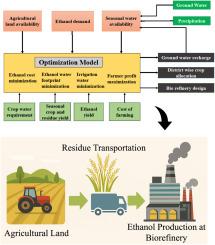考虑水分胁迫的食物-能量-水关系区域可持续性研究
IF 3.9
2区 工程技术
Q2 COMPUTER SCIENCE, INTERDISCIPLINARY APPLICATIONS
引用次数: 0
摘要
在这项工作中,开发了一个区域优化模型,以实现木质纤维素生物燃料中能源-水关系的可持续性。区域可利用水量作为降水的函数来确定。在地区一级详细的水平衡说明地下水补给和地表水的可用性。上一季剩下的水可以在下一季使用。提供农业残留物以生产乙醇的作物的取水受到季节性水分胁迫因素的限制。关键的决策变量是选定作物的土地分配和乙醇生产的残留物选择,同时确保达到国家一级的乙醇生产目标。主要目标是在满足乙醇生产目标的同时,使农民的利润最大化、乙醇成本最小化、用水量最小化。并将所得到的多目标混合整数线性规划问题应用于印度马哈拉施特拉邦33个地区的实例研究。结果将模型的优化土地实践与当前实践进行了比较,其中当前土地利用导致78.5%的水资源压力。与目前的土地利用方式相比,进一步减少38.5%的用水量和15%的乙醇混合率,利润减少了27.6%,从388.06美元/公顷降至288.88美元/公顷。每升乙醇的水足迹从937升下降到528升,下降了1.7倍;灌溉用水量从3878立方米/公顷下降到262立方米/公顷,下降了14.8倍。本文章由计算机程序翻译,如有差异,请以英文原文为准。

Regional sustainability of food–energy–water nexus considering water stress using multi-objective modeling and optimization
In this work, a regional optimization model is developed to achieve energy–water nexus sustainability in the context of lignocellulosic biofuels. The regional water availability is determined as a function of precipitation. Detailed water balance at the district level accounts for groundwater recharge and surface water availability. Water left over from the previous season can be used in the next season. The water withdrawal for crops providing agricultural residue to produce ethanol is limited by a seasonal water stress factor. The key decision variables are land allocation for selected crops and choice of residues for ethanol production, all while ensuring state-level ethanol production targets are met. The primary goals are to maximize farmers’ profit, minimize ethanol cost, and minimize water withdrawals while meeting the ethanol production targets. The resulting multi-objective mixed-integer linear programming problem is applied to a case study of 33 districts in Maharashtra, India. Results compare optimized land practices from the model with current practices, where current land use causes 78.5% water stress. Upon further reducing water consumption by 38.5% compared to the current land use practices and for an ethanol blending rate of 15%, profits reduced by 27.6%, from USD 388.06/ha to USD 288.88/ha. The ethanol water footprint decreased 1.7-fold from 937 to 528 liters per liter of ethanol, and irrigation water use dropped 14.8-fold from 3878 to 262 m/ha.
求助全文
通过发布文献求助,成功后即可免费获取论文全文。
去求助
来源期刊

Computers & Chemical Engineering
工程技术-工程:化工
CiteScore
8.70
自引率
14.00%
发文量
374
审稿时长
70 days
期刊介绍:
Computers & Chemical Engineering is primarily a journal of record for new developments in the application of computing and systems technology to chemical engineering problems.
 求助内容:
求助内容: 应助结果提醒方式:
应助结果提醒方式:


